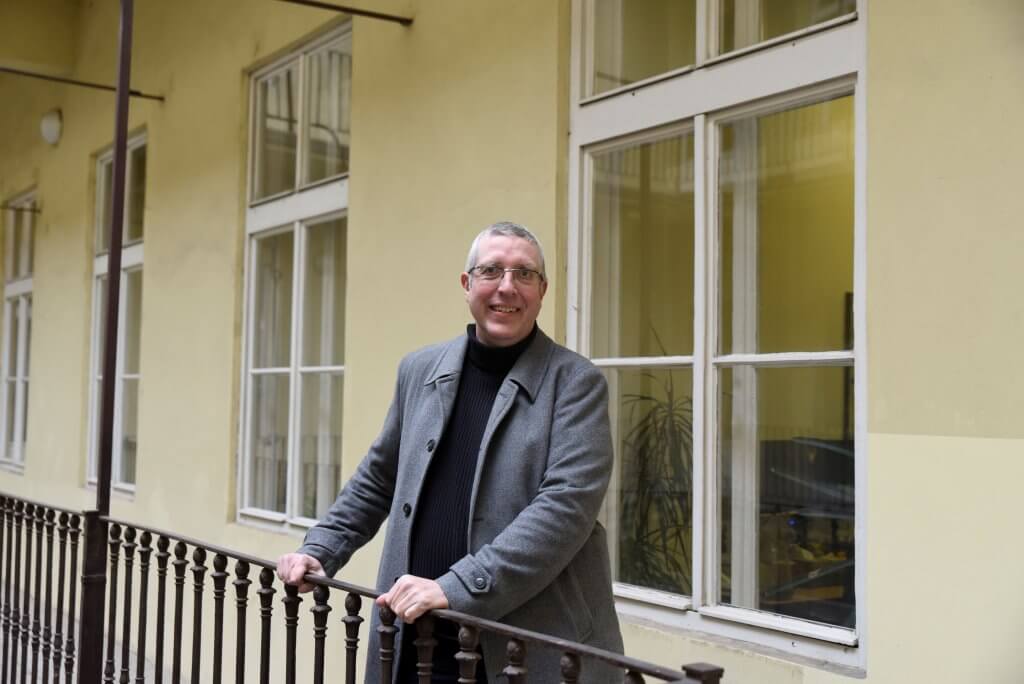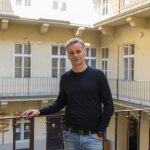Nico Carpentier: We often think of democracy as something that will always stay with us. But recent years have shown the opposite

Read an interview with Nico Carpentier from the Institute of Communication Studies and Journalism. He is an extraordinary professor at Charles University and a visiting professor at several other universities. His research focuses on discourse theory, and he currently leads the research team at FSV UK for the MeDeMAP project, funded by the European Union’s Horizon Europe grant program.
The interview was recorded as part of the De Facto podcast. This episode is hosted by Associate Professor Alice Němcová Tejkalová.

Alice Němcová Tejkalová (ANT): Whenever I talk to anyone in communication studies about you, the same reaction always comes up: What is it like to be a living classic of a powerful subfield—not just within communication studies, but beyond?
Nico Carpentier (NC): It always takes me back to the early years, when I was one of the very few scholars working in discourse studies. I still remember, as a PhD student, speaking with a sociology professor from Louisville. I explained that I was using discourse theory—Laclau and Mouffe—as a theoretical framework. He looked at me and simply said, “That’s impossible.”
That moment actually taught me a couple of valuable lessons. First, when I later became a supervisor myself, I made a point of never doing that—discouraging people is not a good strategy. Second, it showed me just how much of an uphill battle it was to get discourse studies recognized within communication studies, or even acknowledged as overlapping with it. I often think back to those days and still feel surprised it worked. But thanks to the help of so many others—through their own, parallel trajectories—it eventually did become accepted. That’s the feeling I get when I hear something like what you just said.
ANT: Why did you decide to study discourse? What was it that attracted you to a discursive approach—not only to communication but to society and the world more broadly?
NC: Honestly, it was love at first sight. You encounter a concept and you just know—you’re meant to be together. I’m half joking, but it really did feel that way.
ANT: An academic romance, right?
NC: Exactly—like finding a home. Of course, you later rationalize it, but I believe we all have emotional connections to the theories and concepts that drive us. They allow us to speak, to think. We have to find our paradigm—our theory, our model, our way of thinking. Then, looking back, you start to explain it: “Well, I was always interested in meaning, in how people interact with ideas…” So, in that sense, discourse theory was a natural fit. But yes, it started as love at first sight.
ANT: In the introduction to your latest book, co-authored with Jeffrey Wimmer from the University of Augsburg and published by Taylor and Francis—Democracy and Media in Europe: A Discursive-Material Approach—you describe it as a theoretical reflection on the intersection of democracy and media through a constructionist lens. What should we imagine under those words?
NC: Probably something too difficult to read! No, seriously—the core idea is that democracy is not stable. We tend to think of it as something fixed, permanent, something that will always be there. We have our procedures, we have our institutions, we connect it all to the media, and it feels solid.
But I think recent years have painfully shown that democracy is not a given. It changes, and if we want to keep it, we have to protect it. We have to intervene. Constructions are things we create together—no one individual can control them entirely. They’re social processes, but we can still engage, protect, and preserve them. Not everything needs to be kept, of course—but I would argue that democracy is something precious. And if we want to hold onto it, we have to actively maintain that construction. Otherwise, it can slip through our fingers very easily.
ANT: You’ve lived in various countries and seen different approaches to democracy. What do you think is the biggest risk to maintaining it?
NC: There’s a long list of possible threats, but right now I believe the biggest danger is the global push toward more authoritarian regimes and movements. It happens at several levels. We see more authoritarian leadership at the state level, and strong radical-right movements at the political level. These developments erode one of the fundamental principles of democracy: the balance between representation and participation. The participation component is shrinking—and that’s alarming. Because if participation is reduced to nothing but ritualistic voting, then democracy ceases to exist. We end up in an entirely different political system, one where our rights are no longer protected. That’s what truly concerns me.
ANT: Your academic and artistic projects always involve some form of participation. For MeDeMAP, for instance, you’re going to organize “parliaments.” What is this project about?
NC: The book you mentioned was the first step—developing a theoretical framework to better understand the contemporary relationship between democracy and media. But that work was done by academics like us, sitting in our offices, thinking deeply and hopefully coming up with good ideas. Still, that’s just one perspective. It’s rooted in theory and empirical research, but it’s only one voice.
With MeDeMAP, we wanted to create space for other voices—to facilitate public dialogue. We know that participation often comes with frustrations, so our goal was to design a space where ordinary citizens (for lack of a better term) could reflect—just like we did—on the relationship between democracy and media.
The format we chose is known by various names: citizen assembly, citizen parliament… Essentially, it’s a group of people coming together to think and deliberate collectively. The aim is to explore what the future of media and democracy should look like in the Czech Republic.
ANT: In recent years, you’ve been incorporating more art into your work and encouraging others to do the same. What does art bring to your academic practice?
NC: Well, it’s fun! In academia, we’re typically confined to a few very valuable communication tools—writing and speaking, mostly through lectures and papers. But those tools have limitations. I think it’s important to experiment with other languages, other repertoires.
Given my interest in meaning-making, the arts are a natural ally. I’ve worked with sound art for 20–30 years, but more recently I’ve started engaging with visual art—installation, photography, and so on—to tell academic stories in new ways. It’s challenging, but incredibly rewarding. The research we produce is always shaped by the language we use—it both enables and confines us. When we combine different repertoires, we begin to see more.
ANT: And how does the academic community respond? Is it supportive?
NC: I would say yes—supportive, and also a bit respectful of the courage it takes. I remember presenting some of this work years ago in Ljubljana, on a panel with distinguished colleagues. One of them said, “I really respect what you’re doing, but I could never do it myself.” I appreciate that kind of response.
When I talk about arts-based research, I often ask: “Can you dance your research project?” Because you can. I can’t—I’d end up in the hospital, and it wouldn’t be pretty for the audience either. But you can work with dancers, and together create a performance that embodies research. Not everyone can do it, and that’s okay. You have to know your limits—but also recognize the opportunities that come with your own skills and talents.
ANT: You also hosted a remarkable exhibition that was well-received by both students and faculty. It was called The Mirror of Conflict and dealt with conflict and war. Could you tell us more about it?
NC: It’s quite a heavy and somber project, because it addresses the so-called “Cyprus problem.” We could talk about Cyprus for hours—but to put it simply, the island is still divided, with a buffer zone separating the North and the South.
I’ve been working on this project for about ten years, and I’ve been particularly interested in how the enemy—the “other”—is represented in memorials on both sides of the divide. What I found, in the end, was that the representations are structurally the same. People in both the South and the North think about their own suffering, their losses, and their victories in nearly identical ways.
That’s why the exhibition is called The Mirror of Conflict—because each side is quite literally the other’s mirror. They reflect each other’s pain, suffering, and the horrors that war brings. For me, it was a deeply memorable project. You’re confronted with the darkest aspects of human existence. And as academics, we sometimes shield ourselves from that. But if we want to truly understand democracy and peace, we also need to understand what happens when we lose them—when we start seeing the “other” as a threat to be eliminated. There’s a deep loss in that construction of enmity. Understanding that helps us better understand the values of democracy, and the fragility of peace.
Note: The interview was recorded in late January 2025.
Listen to the full podcast below or on Spotify or Apple podcasts.


